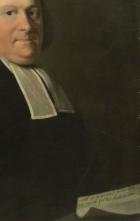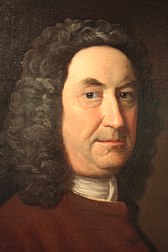Cheffins Cambridge 10 Sep 2003, Lot 520
The Rev Patrick Bennet 1705-1783
Patrick Bennet was born in December 1705, in Muiravonside, Stirlingshire, Scotland, United Kingdom as the son of Andrew Bennet and Elizabeth aka Bettie Livingston. He married Margaret Henderson on 10 December 1752, in Polmont, Stirlingshire, Scotland, United Kingdom. They were the parents of at least 7 sons and 4 daughters. In 1733, at the age of 28, his occupation is listed as minister of Polmont church in Polmont, Falkirk, Scotland, United Kingdom. He died on 12 April 1783, in Polmont, Stirlingshire, Scotland, United Kingdom, at the age of 77, and was buried in Polmont, Stirlingshire, Scotland, United Kingdom.
Patrick Bennet was involved in purchasing 7 acres of Land in 1730 for the erection of the new church, graveyard and Manse. William Douglass of Edinburgh provided the design for a church. The New Manse was built a few years after 1732, Kinneil House is still lived in. Patrick Bennet, the first minister, lived at his own house of Whyteside and the manse was rented out with part of the rent going to the minister. Mr Patrick Bennett became first minister of Polmont Parish Church, with the consent and signatures of all heads of families in the parish to appoint him on the 1 Sep 1732. On the 2 Jun 1736 Patrick Bennet was ordained as minister of Polmont.
There is a walled tomb with a pediment. Inscribed “PATRICK BENNET/ qui obit 12 Aprils 1783/ 78 moan. cet/ ORDAINED FIRST MINISTER OF POLMONT/ 21ST MARCH 1733 “
Polmont was originally included within the parish of Falkirk, but was severed under the authority of the Court of Teinds (teind is the Scots word for tithe), and made an independent parish, in 1724. The parish boundary was from the Firth of Forth up to Muiravonside, and it was later renamed Grangemouth Parish as the port of Grangemouth grew. Nothing of the early history of Polmont has been recorded.
New Polmont was built along the Great North Road (A9), south of Old Polmont, and was originally called Bennetstown or Bennestone (named after the Laird of Whyteside, Mr Bennet, on whose land it was built. Apart from housing, agricultural workshops and stores, it also had three public houses: The Crown, The Red Lion and The Black Bull, but only The Black Bull remains and dates from before 1745. Map of Polmont 1860. The village slowly expanded after World War II with housing being built on land of former estates of Millfield, Polmont Park, and Polmont House. From the mid-1970s, the population significantly expanded when housing was built on the Gilston Estate, whereupon the village was re-designated as a dormitory town.
Allan Ramsay’s studio was in London but he lived regularly in Edinburgh too, Edinburgh was only 23 miles from Polmont.

Allan Ramsay, self-portrait, c. 1737 (now housed at the National Portrait Gallery in London) |
|
| Born | 13 October 1713
Edinburgh, Midlothian, Scotland |
|---|---|
| Died | 10 August 1784 (aged 70) |
| Patron(s) | Duncan Forbes, Duke of Bridgewater, George III |
Allan Ramsay (13 October 1713 – 10 August 1784) was a Scottish portrait-painter.

Ramsay was born in Edinburgh, Scotland, the eldest son of Allan Ramsay, poet and author of The Gentle Shepherd. From the age of twenty he studied in London under the Swedish painter Hans Hysing, and at the St. Martin's Lane Academy; leaving in 1736 for Rome and Naples. In Rome he enrolled as a day student at the French Academy and worked for three years under Francesco Solimena and Imperiali (Francesco Fernandi).
On his return in 1738 to the British Isles, he first settled in Edinburgh, attracting attention by his head of Duncan Forbes of Culloden and his full-length portrait of the Duke of Argyll, later used on Royal Bank of Scotland banknotes. He later moved to London, where he was employed by the Duke of Bridgewater.

His pleasant manners and varied culture, not less than his artistic skill, contributed to render him popular. His only serious competitor was Thomas Hudson, with whom he shared a drapery painter, Joseph Van Aken.
In 1739, he married his first wife, Anne Bayne, the daughter of Alexander Bayne of Rires (c. 1684–1737), and Mary Carstairs (1695?–1759). Anne died on 4 February 1743, giving birth to their 3rd child; none of their children reached adulthood.
One of his drawing pupils was Margaret Lindsay, eldest daughter of Sir Alexander Lindsay of Evelick and Amelia Murray (granddaughter to David Murray, 5th Viscount of Stormont and sister to the naval officer John Lindsay). He later eloped with her and on 1 March 1752 they married in the Canongate Kirk, Edinburgh; her father never forgave her for marrying an artist. Ramsay already had to maintain a daughter from his previous marriage and his two surviving sisters, but told Sir Alexander that he could provide Margaret with an annual income of £100. He said it would increase 'as my affairs increase, and I thank God, they are in a way of increasing' and that his only motive for the marriage was 'my love for your Daughter, who, I am sensible, is entitled to much more than ever I shall have to bestow upon her'.Three children survived from their long and happy marriage, Amelia (1755–1813), Charlotte (1758–1818?), and John (1768–1845).
Ramsay and his new wife spent 1754 to 1757 together in Italy, going to Rome, Florence, Naples and Tivoli, researching, painting and drawing old masters, antiquities and archaeological sites. He earned income painting Grand Tourists' portraits. This and other trips to Italy involved more literary and antiquarian research than art. After their return, Ramsay in 1761 was appointed to succeed John Shackelton as Principal Painter in Ordinary to George III, beating Hudson to the post.The king commissioned so many royal portraits to be given to ambassadors and colonial governors, that Ramsay used the services of numerous assistants—of whom David Martin and Philip Reinagle are the best known.
He gave up painting in about 1770 to concentrate on literary pursuits. His health was shattered by an accidental dislocation of the right arm and his second wife's death in 1782. With unflinching pertinacity, he struggled until he had completed a likeness of the king upon which he was engaged at the time, and then started for his beloved Italy. He left a series of 50 royal portraits to be completed by his assistant Reinagle. For several years he lingered in the south, his constitution finally broken. He died at Dover on 10 August 1784.
Ramsay was a friend of Samuel Johnson's, who said of him, 'I love Ramsay. You will not find a man in whose conversation there is more instruction, more information, and more elegance, than in Ramsay's.'

Among his most satisfactory productions are some of his earlier ones, such as the full-length of the Duke of Argyll, and the numerous bust-portraits of Scottish gentlemen and their ladies which he executed before settling in London. They are full of both grace and individuality; the features show excellent draughtsmanship; and the flesh-painting is firm and sound in method, though frequently tending a little to hardness and opacity. His full-length of Lady Mary Coke is remarkable for the skill and delicacy with which the white satin drapery is managed; while the portrait of his brown-eyed second wife Margaret, in the Scottish National Gallery, is described as having a sweetness and tenderness. The portrait of his wife also shows the influence of French art, which Ramsay incorporated into his work. The large collection of his sketches in the possession of the Royal Scottish Academy and the Board of Trustees, Edinburgh also show this French elegance and soft colours.
In a documentary broadcast by the BBC in February 2014, Ramsay was shown to be the artist who painted the lost portrait of Charles Edward Stuart in 1745, completed on the verge of his invasion of England.

Ramsay has paintings in the collection of a few British institutions including the National Gallery in London, Sheffield, Derby Art Gallery (attributed), Glasgow Museum and Newstead Abbey.
In 2016 a portrait of Richard Mead (King George II's physician) by Allan Ramsay was discovered by Bendor Grosvenor (using the Art UK website) as part of the British BBC4 television programme Britain's Lost Masterpieces; conservation treatment was carried out by Simon Rollo Gillespie to repair the torn canvas and remove layers of discoloured varnishes.
One of Ramsay's most famous paintings is entitled simply "Portrait of an African" and has attracted extensive attention across recent decades, both as a representation of an individual African in 18th century Britain, but also for the difficulty of identifying the sitter. A documentary featuring this painting explores the many meanings of this enigmatic images has been produced by Royal Albert Memorial Museum & Art Gallery in Exeter.
In 1755, Ramsay made a considerable contribution to the Greco-Roman controversy, which was mainly discussed in Paris and Rome, when he anonymously published his Dialogue on Taste in which he named Greece as the superior source of artistic excellence. According to Mario de Valdes y Cocom in 2009 on an edition of PBS Frontline, in several paintings of Queen Charlotte, Ramsay deliberately emphasised "mulatto features" which the queen supposedly inherited via descent from a 13th-century Moorish ancestor. Valdes suggests that copies of these paintings were sent to the colonies to be used by abolitionists as a de facto support for their cause.
Other historians question whether the 13th-century ancestor, referred to in various places as a 'Moor' and Berber, was black African. In any event, they contend that the connection, nine and 15 generations removed, was too distant to consider Charlotte 'black' in any way, as her other ancestors were all European.
- Allan Ramsay's works
-
Self-portrait, 1756
-
Portrait of his second wife, Margaret Lindsay
-
The lost portrait of Charles Edward Stuart, painted in Edinburgh in 1745
-
Queen Charlotte as painted by Allan Ramsay in 1762
-
Portrait of David Hume, 1754
-
Portrait of David Hume, 1766
-
Lady in a Pink Silk Dress
-
John Burgoyne, painted in Rome in 1758
-
Sir John St. Clair, 1754
















